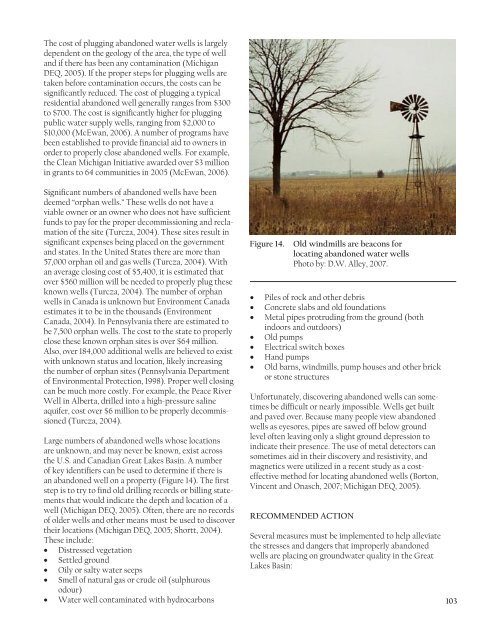Groundwater in the Great Lakes Basin
Groundwater in the Great Lakes Basin
Groundwater in the Great Lakes Basin
You also want an ePaper? Increase the reach of your titles
YUMPU automatically turns print PDFs into web optimized ePapers that Google loves.
The cost of plugg<strong>in</strong>g abandoned water wells is largely<br />
dependent on <strong>the</strong> geology of <strong>the</strong> area, <strong>the</strong> type of well<br />
and if <strong>the</strong>re has been any contam<strong>in</strong>ation (Michigan<br />
DEQ, 2005). If <strong>the</strong> proper steps for plugg<strong>in</strong>g wells are<br />
taken before contam<strong>in</strong>ation occurs, <strong>the</strong> costs can be<br />
significantly reduced. The cost of plugg<strong>in</strong>g a typical<br />
residential abandoned well generally ranges from $300<br />
to $700. The cost is significantly higher for plugg<strong>in</strong>g<br />
public water supply wells, rang<strong>in</strong>g from $2,000 to<br />
$10,000 (McEwan, 2006). A number of programs have<br />
been established to provide f<strong>in</strong>ancial aid to owners <strong>in</strong><br />
order to properly close abandoned wells. For example,<br />
<strong>the</strong> Clean Michigan Initiative awarded over $3 million<br />
<strong>in</strong> grants to 64 communities <strong>in</strong> 2005 (McEwan, 2006).<br />
Significant numbers of abandoned wells have been<br />
deemed “orphan wells.” These wells do not have a<br />
viable owner or an owner who does not have sufficient<br />
funds to pay for <strong>the</strong> proper decommission<strong>in</strong>g and reclamation<br />
of <strong>the</strong> site (Turcza, 2004). These sites result <strong>in</strong><br />
significant expenses be<strong>in</strong>g placed on <strong>the</strong> government<br />
and states. In <strong>the</strong> United States <strong>the</strong>re are more than<br />
57,000 orphan oil and gas wells (Turcza, 2004). With<br />
an average clos<strong>in</strong>g cost of $5,400, it is estimated that<br />
over $560 million will be needed to properly plug <strong>the</strong>se<br />
known wells (Turcza, 2004). The number of orphan<br />
wells <strong>in</strong> Canada is unknown but Environment Canada<br />
estimates it to be <strong>in</strong> <strong>the</strong> thousands (Environment<br />
Canada, 2004). In Pennsylvania <strong>the</strong>re are estimated to<br />
be 7,500 orphan wells. The cost to <strong>the</strong> state to properly<br />
close <strong>the</strong>se known orphan sites is over $64 million.<br />
Also, over 184,000 additional wells are believed to exist<br />
with unknown status and location, likely <strong>in</strong>creas<strong>in</strong>g<br />
<strong>the</strong> number of orphan sites (Pennsylvania Department<br />
of Environmental Protection, 1998). Proper well clos<strong>in</strong>g<br />
can be much more costly. For example, <strong>the</strong> Peace River<br />
Well <strong>in</strong> Alberta, drilled <strong>in</strong>to a high-pressure sal<strong>in</strong>e<br />
aquifer, cost over $6 million to be properly decommissioned<br />
(Turcza, 2004).<br />
Large numbers of abandoned wells whose locations<br />
are unknown, and may never be known, exist across<br />
<strong>the</strong> U.S. and Canadian <strong>Great</strong> <strong>Lakes</strong> Bas<strong>in</strong>. A number<br />
of key identifiers can be used to determ<strong>in</strong>e if <strong>the</strong>re is<br />
an abandoned well on a property (Figure 14). The first<br />
step is to try to f<strong>in</strong>d old drill<strong>in</strong>g records or bill<strong>in</strong>g statements<br />
that would <strong>in</strong>dicate <strong>the</strong> depth and location of a<br />
well (Michigan DEQ, 2005). Often, <strong>the</strong>re are no records<br />
of older wells and o<strong>the</strong>r means must be used to discover<br />
<strong>the</strong>ir locations (Michigan DEQ, 2005; Shortt, 2004).<br />
These <strong>in</strong>clude:<br />
• Distressed vegetation<br />
• Settled ground<br />
• Oily or salty water seeps<br />
• Smell of natural gas or crude oil (sulphurous<br />
odour)<br />
• Water well contam<strong>in</strong>ated with hydrocarbons<br />
Figure 14.<br />
Old w<strong>in</strong>dmills are beacons for<br />
locat<strong>in</strong>g abandoned water wells<br />
Photo by: D.W. Alley, 2007.<br />
• Piles of rock and o<strong>the</strong>r debris<br />
• Concrete slabs and old foundations<br />
• Metal pipes protrud<strong>in</strong>g from <strong>the</strong> ground (both<br />
<strong>in</strong>doors and outdoors)<br />
• Old pumps<br />
• Electrical switch boxes<br />
• Hand pumps<br />
• Old barns, w<strong>in</strong>dmills, pump houses and o<strong>the</strong>r brick<br />
or stone structures<br />
Unfortunately, discover<strong>in</strong>g abandoned wells can sometimes<br />
be difficult or nearly impossible. Wells get built<br />
and paved over. Because many people view abandoned<br />
wells as eyesores, pipes are sawed off below ground<br />
level often leav<strong>in</strong>g only a slight ground depression to<br />
<strong>in</strong>dicate <strong>the</strong>ir presence. The use of metal detectors can<br />
sometimes aid <strong>in</strong> <strong>the</strong>ir discovery and resistivity, and<br />
magnetics were utilized <strong>in</strong> a recent study as a costeffective<br />
method for locat<strong>in</strong>g abandoned wells (Borton,<br />
V<strong>in</strong>cent and Onasch, 2007; Michigan DEQ, 2005).<br />
RECOMMENDED ACTION<br />
Several measures must be implemented to help alleviate<br />
<strong>the</strong> stresses and dangers that improperly abandoned<br />
wells are plac<strong>in</strong>g on groundwater quality <strong>in</strong> <strong>the</strong> <strong>Great</strong><br />
<strong>Lakes</strong> Bas<strong>in</strong>:<br />
103

















